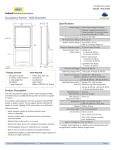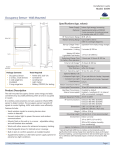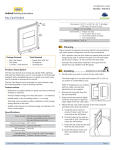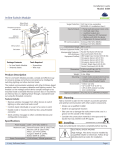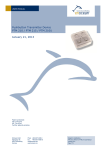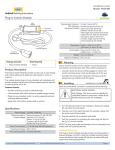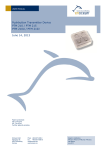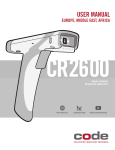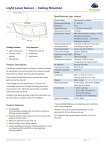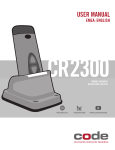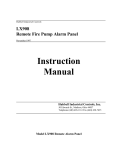Download wiSTAR Occupancy Sensor - Ceiling Mounted Install Instructions
Transcript
Installation Guide Model: WIS-OSC Hubbell Building Automation Occupancy Sensor - Ceiling Mounted Specifications Power Supply Indoor light energy harvesting Optional: supplemental battery or 2-wire connector for external power or remote solar cell (3-5 VDC) RF Communications EnOcean 902 MHz RF Transmission Range 80 ft. (25 m) Motion Sensing Range 30 ft. (25 m) diameter (refer to coverage diagrams) Minimum Operating Light 50 lux (for auto-off only) Startup Charge Times* (from empty) Linking only 4 minutes @ 100 lux 1.5 minutes @ 200 lux Motion Transmission 6 minutes @ 100 lux 3.5 minutes @ 200 lux Package Contents ▪ Occupancy Sensor ▪ 2 screws, 2 wall anchors ▪ Wire bracket Tools Required ▪ ▪ ▪ ▪ Power drill, 3/16” bit Screwdriver Light meter Battery (CR2032) for testing Light/Walk Test Modes 5.5 hours @ 200 lux Time to Full Charge* Sustaining Charge Time Motion Transmission Interval 9 hours @ 200 lux 3 hours per 24 hours @ 200 lux Variable 60 - 300 seconds (based on real-time charge rate) 60 sec @ 200 lux - 300 sec @ 50 lux Heartbeat Transmission Interval Product Description 120 sec @ 200 lux - 600 sec @ 50 lux + 0-50 sec randomized delay The ceiling-mounted Occupancy Sensor saves energy and adds convenience by accurately detecting when an area is occupied or vacant. Operating Life in Total Darkness EEP (EnOcean Equipment Profile) This device is wireless, powered by indoor light, and uses a passive infrared (PIR) sensor to detect motion. The occupancy sensor transmits RF signals to control lighting, HVAC and outlets more efficiently. Dimensions Weight Features Include: Mounting Height ▪ Sends wireless messages to other devices when motion is detected Environment ▪ Harvests ambient solar energy to power the sensor and wire- 48 hours (after full charge) A5-07-02 6.30” L x 2.35” W x 1.47” D (160mm x 60mm x 37mm) 4.4 oz. (125 g) 7-10’ (recommended) Indoor use only 14° to 104°F (-10° to 40°C) less communication ▪ ▪ ▪ ▪ Variable 120 - 600 seconds (based on real-time charge rate) 20% to 95% relative humidity (non-condensing) Mounts easily on any ceiling material Agency Compliance Works with other sensors for enhanced occupancy tracking FCC, IC, RoHS Built-in tests to confirm operation at installed location Supplemental battery or alternative power supply options for extreme low-light conditions © 2013 Hubbell Building Automation | * Sunlight, bright lighting or a battery can be temporarily used to significantly shorten startup charge times. www.hubbell-automation.com Page 1 Occupancy Sensor – Ceiling Mounted • Installation Guide Functional Description If occupation is detected by the permanently active PIR sensor, a radio telegram indicating the occupied status will transmit immediately. A motion transmission interval timer starts to run with a variable timer length varying between 60 and 300 seconds, depending on the light level. No radio telegrams will be sent out until the timer expires. After the timer has expired, the unit will transmit again if occupancy was detected during the timer interval period. If occupancy was not detected, the unit will transmit a heartbeat signal - sending the unoccupied heartbeat status message every 2 - 11 minutes (depending on the light level). Planning Take a moment to plan for the sensor’s successful operation and optimal communication with other system components. Remove the sensor from its packaging and place it under a bright light to provide the required startup charge. Optionally, to ensure the sensor energy storage is fully charged, insert a CR2032 battery for 5 minutes while in a well-lit location. ▪ ▪ ▪ ▪ To provide coverage for very high ceilings, a wall sensor can be incorporated in the plan for complete coverage. Installing estimated time: 20 minutes The occupancy sensor can be mounted on most ceilings with the provided screws, or mounted on dropped ceilings, using the provided wire bracket. NOTE: It is often easier to link the sensor before it is mounted on the ceiling. Refer to the “Linking” section. Locate the sensor between 7 - 10 ft (2.1 to 3 m) high 1. Decide where you want to install the occupancy sensor. Tip: For visual alignment, orient the sensor parallel to one of the walls. Avoid installed near ceiling fan or hanging light fixtures 2. Remove the mounting plate from the sensor. Ensure the location provides consistent and adequate light Consider the area’s traffic patterns and principal use, for example, walking, working, lounging or sleeping ▪ Provide a minimum clearance of 4 ft. (1.2 m) away from heat 3. Decide which of the two installation options is appropriate. A. Screw Mounting Plate to the Ceiling i. sources, light bulbs, forced air, or ventilation systems ▪ Consider the construction materials (such as metal) in the space and obstacles that may interfere with RF signals Hold the mounting plate in place on the ceiling and use a pencil to lightly mark two small dots for the screw drill points. ii. Drill two holes with a 3/16” drill bit and insert the wall anchors. Sensor Range A single occupancy sensor provides sufficient coverage for most applications. For some applications, multiple sensors may be required to provide complete coverage. iii. Insert the first screw loosely and level the mounting plate. Coverage Diagrams iv. Insert the second screw and then hand-tighten the first screw. B. Mount Using the Wire Bracket i. Remove the ceiling tile where you want to mount the sensor. ii. Place the mounting plate squarely on the ceiling tile and use the wire to mark two points for the holes. iii. Punch two small holes through the ceiling tile at the marked points. iv. Insert the wire bracket through the two holes in the mounting plate. Make sure the ends are roughly even. © 2013 Hubbell Building Automation | www.hubbell-automation.com Page 2 Occupancy Sensor – Ceiling Mounted • Installation Guide v. Feed the wires through the holes in the ceiling tile. The Occupancy Sensor is a Transmit-only Device. To link the occupancy sensor to a transceiver; the transceiver must first be powered, within wireless range of the sensor, and set to accepts links. Next, the desired transmitter, or another transceiver, is triggered to send a special link message. The awaiting transceiver receives and stores the link permanently so the devices can interact to provide a variety of intelligent control options. vi. On the front of the ceiling tile, flatten the wire bracket so it is snug against the mounting plate. To Link or Unlink an Occupancy Sensor 1. Set the desired transceiver to the desired Link/Unlink mode. (refer to that device’s installation guide). 2. Click the Menu button on the bottom of the sensor once. This sends a link/unlink radio telegram. vii. On the back of the ceiling tile, twist the wires together to hold the mounting plate securely. viii. Replace the ceiling tile. 4. Attach the sensor to the mounting plate. With the 2-button interface facing you, slide the sensor to the left on the mounting plate until it snaps into place. NOTE: The button interface on the sensor is used for linking and testing only. The occupancy timer settings are configured on the transceiver to which the sensor is linked. Refer to the “Linking” section of the transceiver/controller installation guides to complete the linking & setup process. Testing the Sensor Before starting a test, ensure the sensor’s energy storage is fully charged by placing it under bright light (at least 500 lux) for 20 minutes, or insert a battery for 5 minutes while in a well-lit area. NOTE: If the sensor does not have a sufficient charge, it cannot enter into the test modes. No LED light or 1 red blink when the test button is pressed indicates insufficient charge. If a battery is used to charge the sensor for a light test, ensure it is removed to get an accurate light measurement. 5. Confirm the sensor is properly positioned to detect motion and has sufficient light to operate - refer to the “Walk Test” and “Light Test” sections. Linking Two or more compatible devices can be linked and configured to provide the desired control. There are two basic types of devices in the system; transmitters and transceivers. ▪ Transmit-only: Transmitters are simple energy-harvesting devices that send RF messages to communicate a condition, level, or state. Transmitters can only be linked to transceivers. Examples > Self-powered Light Switches, Occupancy Sensors ▪ Transmit & Receive: Transceivers are controlling devices that send as well as receive RF messages. They also process relevant control logic, and actuate the appropriate outputs (switching a light on or off for example). Transceivers can be linked with transmitters as well as other transceivers. A transceiver can have up to 30 devices linked to it. Examples > Relays, Gateways © 2013 Hubbell Building Automation | A test mode will stay active for 3 minutes. To exit a test and resume normal operation, press and hold the Menu button for 5 seconds. Walk Test Use the walk test to confirm that motion is within the sensor’s range. 1. Press and hold the Set button for 5 seconds. ••> Red LED will blink to confirm that a walk test is active. 2. Move in and out of the sensor‘s range to determine its coverage area. ••> Sensor will blink when it detects motion. 3. Make small hand movements just inside the limit of the sensor‘s range to see if the motion triggers a response. NOTE: Ensure the sensor does not falsely trigger from user activity outside the desired zone or other heat and motion sources. If false triggering occurs, adjust the sensitivity switch (next to the battery slot) from REG to LOW. www.hubbell-automation.com Page 3 Occupancy Sensor – Ceiling Mounted • Installation Guide Troubleshooting Light Test Use the light test to measure real-time light levels and confirm whether the occupancy sensor has sufficient light. 1. Create a realistic lighting condition (the test measures the real-time light level). 2. Press and hold the Set button for 10 seconds. ••> Red & green LEDs will blink to confirm light test is active. 3. Watch the LED blink rate to determine the light strength. ••> The highest is 5 blinks which indicates very good light (200 lux or more). 1 blink indicates minimum light (<25 lux). NOTE: If there is no blink rate, consider relocating the sensor or installing a battery to provide supplemental power. Installing Supplemental Battery (optional) If light levels are very low where the sensor is installed, auxiliary battery power (CR2032) can be used to supplement the solar energy harvester. Problem 2. Turn the sensor over and identify the battery holder on the circuit board ▪ Sensor is activated when there is nothing to detect ▪ ▪ ▪ ▪ ▪ ▪ Linked device does not respond to wireless messages ▪ Explanation of Occupied & Heartbeat Message Data Telegrams 902 MHz: 1. Remove the sensor from the mounting plate. With the push-button interface facing you, slide the sensor to the right. Solution Checklist Sensor does not generate a wireless message Verify the LED blinks when motion is detected during a walk test Verify the solar cell is charged properly Verify there is 4 ft. (1.2 m) clearance from heat sources that may disturb sensing Reduce sensitivity setting by moving the PIR sensitivity switch on the back from REG to LOW (the left-hand position) Check for environment or range issues Verify the device is linked Check the transceiver connection and the wiring for errors Check if appropriate devices are linked according to good system planning Data Byte 3: Super Capacitor Voltage, 0-255 (% of 0-4.5V) Data Byte 2: Solar Panel Current, 0-127 microA Data Byte 1: 0xFF (occupied) or 0x00 (unoccupied) Data Byte 0: 0x0F FCC: SZV-EOSW05 IC: 5713-EOSW05 This device complies with part 15 of the FCC rules and Industry Canada ICES-003. Operation is subject to the following two conditions: (1) This device may not cause harmful interference, and (2) this device must accept any interference received, including interference that may cause undesired operation. IMPORTANT! Any changes or modifications not expressly approved by the party responsible for compliance could void the user’s authority to operate this equipment. Le présent appareil est conforme aux CNR d’Industrie Canada applicables aux appareils radio exempts de licence. L’exploitation est autorisée aux deux conditions suivantes: (1) l’appareil ne doit pas produire de brouillage, et (2) l’utilisateur de l’appareil doit accepter tout brouillage radioélectrique subi, meme si le brouillage est susceptible d’en compromettre le fonctionnement. IMPORTANT! Tous les changements ou modifications pas expressément approuvés par la partie responsable de la conformité ont pu vider l’autorité de l’utilisateur pour actioner cet équipment. Limited Warranty ONE YEAR 3. Insert the battery under the clip with the positive pole (+) up and press it in place. 4. Remount the sensor on the mounting plate. © 2013 Hubbell Building Automation | www.hubbell-automation.com Page 4 XOSCIGPLA




